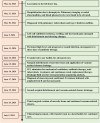Acute Necrotizing Fasciitis Caused by Rhizopus Infection in a Patient with Diabetes and Pulmonary Tuberculosis: A Case Report
- PMID: 39958980
- PMCID: PMC11827498
- DOI: 10.2147/IDR.S503791
Acute Necrotizing Fasciitis Caused by Rhizopus Infection in a Patient with Diabetes and Pulmonary Tuberculosis: A Case Report
Abstract
Background: Zygomycosis, also termed mucormycosis, is a rare yet highly fatal fungal infection caused by Mucorales species, notably Rhizopus spp.
Case presentation: This case study details a 72-year-old man with diabetes, pulmonary tuberculosis, and nephrotic syndrome who developed acute necrotizing fasciitis attributable to R. oryzae. Despite initial empirical antibiotic therapy, the infection progressed rapidly. Metagenomic next-generation sequencing (mNGS) facilitated a swift diagnosis, identifying R. oryzae in blood and drainage samples. The treatment included amphotericin B and isavuconazole, along with aggressive surgical debridement. The patient exhibited substantial improvement, and he was discharged after stabilization.
Conclusion: This case highlights the critical role of early diagnosis through mNGS and the need for a multidisciplinary approach to manage severe mucormycosis in immunocompromised patients.
Keywords: Rhizopus infection; acute necrotizing fasciitis; case report; diabetes.
© 2025 Huang et al.
Conflict of interest statement
The authors report no conflicts of interest in this work.
Figures






Similar articles
-
[Pulmonary zygomycosis--a rare angioinvasive fungal infection].Mycoses. 2005;48 Suppl 1:99-107. doi: 10.1111/j.1439-0507.2005.01118.x. Mycoses. 2005. PMID: 15826297 German.
-
Diabetes-associated central nervous system mucormycosis with delayed diagnosis: a case report.Front Neurol. 2025 May 6;16:1596136. doi: 10.3389/fneur.2025.1596136. eCollection 2025. Front Neurol. 2025. PMID: 40395765 Free PMC article.
-
Oral Isavuconazole Combined with Nebulized Inhalation and Bronchoscopic Administration of Amphotericin B for the Treatment of Pulmonary Mucormycosis: A Case Report and Literature Review.J Fungi (Basel). 2024 May 29;10(6):388. doi: 10.3390/jof10060388. J Fungi (Basel). 2024. PMID: 38921374 Free PMC article.
-
A case of rhinoorbital mucormycosis in a leukemic patient with a literature review from Turkey.Mycopathologia. 2011 Nov;172(5):397-405. doi: 10.1007/s11046-011-9449-z. Epub 2011 Jul 15. Mycopathologia. 2011. PMID: 21761152 Review.
-
[Clinical analysis of 3 cases of mucormycosis in children with acute lymphoblastic leukemia and literature review].Zhonghua Er Ke Za Zhi. 2022 Jan 2;60(1):56-61. doi: 10.3760/cma.j.cn112140-20210711-00571. Zhonghua Er Ke Za Zhi. 2022. PMID: 34986625 Review. Chinese.
References
Publication types
LinkOut - more resources
Full Text Sources
Miscellaneous

